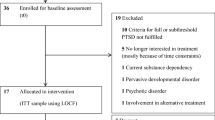Abstract
Persons exposed to traumatic events in childhood and adolescence may suffer from the symptoms of posttraumatic stress disorder (PTSD) well into old age. The aim of this paper is to introduce a structured life-review technique for the treatment of elderly PTSD patients. This technique centers on the discussion and evaluation of each consecutive stage of life. The therapist encourages the patient to reminisce on both positive and negative experiences; positive coping experiences are reinforced. A single session on the traumatic event is integrated into the discussion of the stages of life, which are dealt with in chronological order. In the following, 3 case studies (e.g., survivors of the 1945 Dresden bombing) are presented. Psychometric measures (PTSS-10, IES-R) for the case studies are reported. Finally, the potential and limitations of the pilot study and the new approach are discussed.
Similar content being viewed by others
REFERENCES
American Psychiatric Association (1994). Diagnostic and Statistical Manual of Mental Disorders, 4th edn., American Psychiatric Association, Washington, DC.
Butler, R. N. (1963). The life review. An interpretation of reminiscence in the aged. Psychiatry 26: 65–76.
Coleman, P. G. (1999). Creating a life story. The task of reconciliation. Gerontologist 39: 133–139.
Connell, P., and Thompson, C. (1986). Flexibility of single-subject experimental designs. J. Speech Hear. Disord. 51: 214–255.
Ehlers, A., and Clark, D. M. (1999). A cognitive model of posttraumatic stress disorder. Behav. Res. Ther. 54: 1–25.
Erikson, E. H. (1982). The Life Cycle Completed, Norton, New York.
Foa, E. B., and Rothbaum, B. O. (1998). Treating the Trauma of Rape. Cognitive Behavioral Therapy for PTSD, Guilford, New York.
Haight, B. K., Coleman, P., and Lord, K. (1997). The linchpins of a successful life review: Structure, evaluation, and individuality. In Haight, B. K., and Webster, J. D. (eds.), The Art and Science of Reminiscing. Theory, Research, Methods, &; Applications, Taylor and Francis, Washington, DC.
Haight, B. K., and Webster, J. D. (eds.) (1995). The Art and Science of Reminiscence: Theory, Research, Methods, and Applications, Taylor and Francis, Washington, DC.
Kruse, A., and Schmitt, E. (1999). Reminiscence of traumatic experiences in (former) Jewish emigrants and extermination camp survivors. In Maercker, A., Schützwohl, M., and Solomon, Z. (eds.), Post-Traumatic Stress Disorder. A Lifespan Developmental Perspective, Hogrefe and Huber, Seattle, WA.
Maercker, A., and Herrle, J. (in press). Long-term effects of the Dresden bombing: Relationships to control beliefs, religious beliefs, and personal growth. J. Trauma. Stress.
Maercker, A., and Schützwohl, M. (1998). Erfassung von psychischen Belastungsfolgen: Die Impact of Event Skala-revidierte Version (IES-R). Diagnostica 44: 130–141.
Maercker, A., and Zöllner, T. (2002). Life-Review-Therapie als spezifische Form der Behandlung posttraumatischer Belastungsstörungen im Alter. Verhaltensth. &; Verhaltensmed. 23: 120–140.
Margraf, J., Schneider, S., and Ehlers, A. (1996). DIPS. Diagnostisches Interview bei psychischen Störungen, 2nd edn., Springer, Berlin, Germany.
Neugarten, B. L. (1968). Adult Personality: Toward a Psychology of the Life Cycle, University of Chicago Press, Chicago.
Park, C. (1999). The roles of meaning and growth in the recovery from Posttraumatic stress disorder. In Maercker, A., Schützwohl, M., and Solomon, Z. (eds.), Post-Traumatic Stress Disorder: A Lifespan Developmental Perspective, Hogrefe and Huber, Seattle, WA.
Resick, P. A., and Schnicke, M. K. (1993). Cognitive Processing Therapy for Rape Victims, Sage, Newbury Park, CA.
Schindler, R., Spiegel, C., and Malachi, E. (1992). Silences: Helping elderly Holocaust Victims deal with the past. Int. J. Aging Hum. Dev. 35: 243–252.
Schützwohl, M., and Maercker, A. (1999). Effects of varying diagnostic criteria for PTSD. J. Trauma. Stress 12: 155–165.
Scogin, F., and McElreath, L. (1994). Efficacy of psychosocial treatments for Geriatric depression. A quantitative review. J. Consul. Clin. Psychol. 62: 69–74. Life-Review TechniqueWith Elderly PTSD Patients 249
Solomon, Z., and Ginzburg, K. (1999). Aging in the shadow of war. In Maercker, A., Schützwohl, M., and Solomon, Z. (eds.), Post-Traumatic Stress Disorder: A Lifespan Developmental Perspective, Hogrefe and Huber, Seattle, WA.
Stoll, C., Kapfhammer, H. P., Rothenhäusler, H. B., Haller, M., Briegel, J., Schmidt, M., Krauseneck, T., Durst, K., and Schelling, G. (1999). Sensitivity and specificity of a screening test to document traumatic experiences and to diagnose PTSD in ARDS patients after intensive care treatment. Intensive Care Med. 25: 697–704.
Strack, S., and Feifel, H. (1996). Age differences, coping, and the adult life span. In Zeidler, M., and Endler, N. S. (eds.), Handbook of Coping, Wiley, New York.
Tedeschi, R. G., and Calhoun, L. G. (1995). Trauma and Transformation. Growing in the Aftermath of Suffering, Sage, Thousand Oaks, CA.
van Etten, M. L., and Taylor, S. (1998). Comparative efficacy of treatments for posttraumatic stress disorder: A meta-analysis. Clin. Psychol. Psychother. 5: 126–144.
Weintraub, D., and Ruskin, P. E. (1999). Posttraumatic stress disorder in the elderly:Areview. Harv. Rev. Psychiatry 7: 144–152.
Weisaeth, L. (1989). A study of behavioural responses to an industrial disaste. Acta Psychiatr. Scand. 355 (Suppl.), 13–24.
Weiss, D. S., and Marmar, C. R. (1996). The Impact of Event Scale–Revised. In Wilson, J. P., and Keane, T. M. (eds.), Assessing Psychological Trauma and PTSD, Guilford, New York, pp. 399–411.
World Health Organization (1993). Tenth Revision of the International classification of Diseases, Chapter V (F): Mental and Behavioral Disorders, World Health Organization, Geneva.
Author information
Authors and Affiliations
Rights and permissions
About this article
Cite this article
Maercker, A. Life-Review Technique in the Treatment of PTSD in Elderly Patients: Rationale and Three Single Case Studies. Journal of Clinical Geropsychology 8, 239–249 (2002). https://doi.org/10.1023/A:1015952429199
Issue Date:
DOI: https://doi.org/10.1023/A:1015952429199




